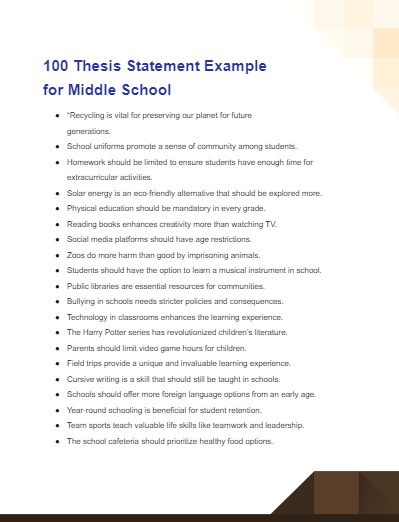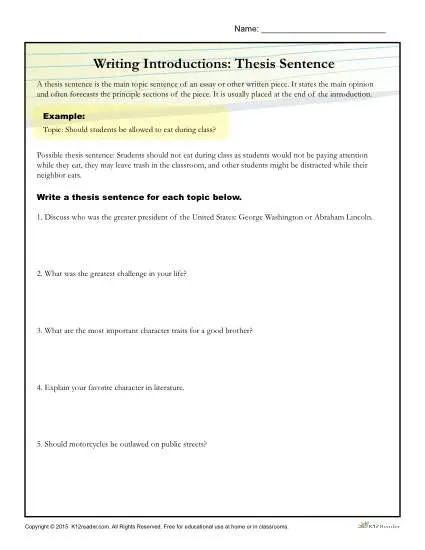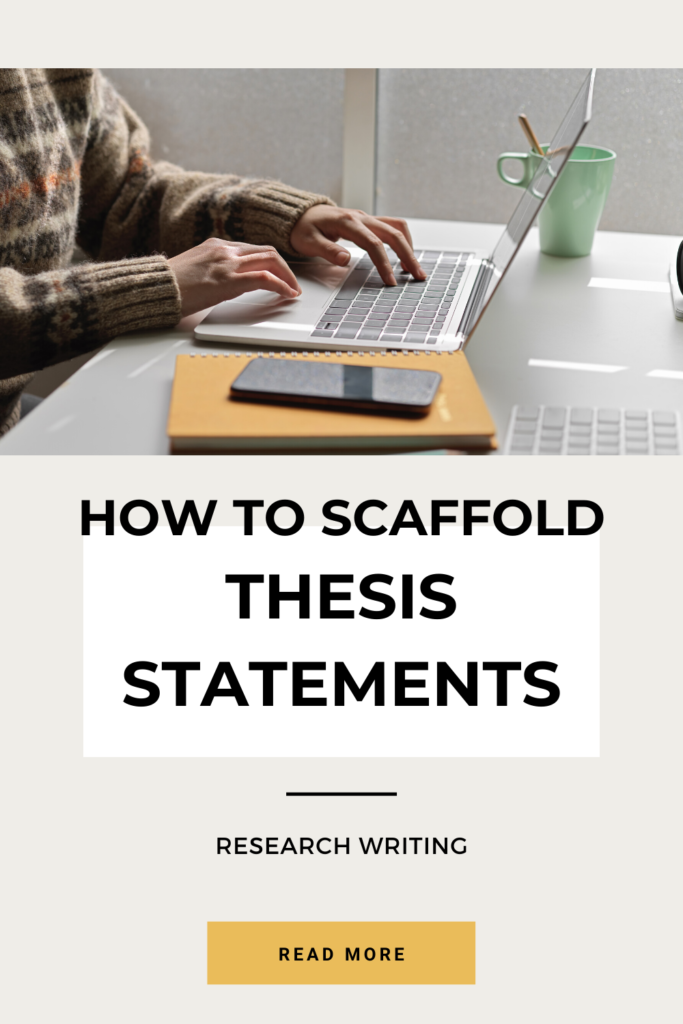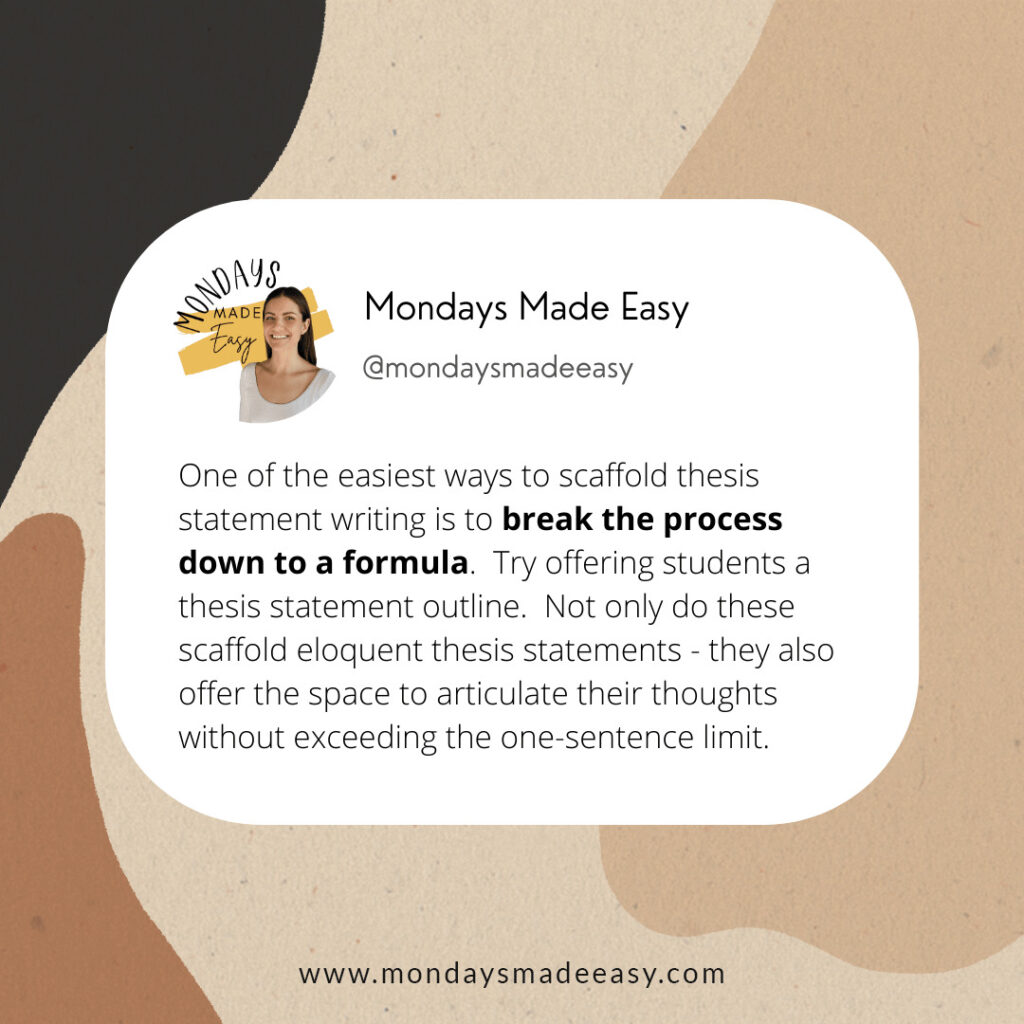

Middle School Thesis Statement
Ai generator.

In middle school, students begin to familiarize themselves with the concept of thesis statements , laying the groundwork for more complex writing tasks in the future. Crafting a thesis statement at this level is crucial for developing strong writing skills and analytical thinking. This guide provides middle schoolers with essential examples, a step-by-step approach to writing, and helpful tips to ensure they create compelling and clear thesis statements to elevate their essays and reports.
What is a thesis statement for middle schoolers? – Definition
A thesis statement for middle schoolers is a concise sentence or two that clearly presents the main idea or argument of a piece of writing. It serves as a roadmap for readers, helping them understand what the writer intends to convey or prove. For middle school students, a thesis statement often takes a simpler form than in more advanced academic writing but remains essential for guiding the direction of their essays, reports, or projects.
What is a good thesis statement Example for Middle School?
“Despite its reputation for being an aggressive breed, with proper training and socialization, pit bulls can be loyal and gentle family pets.”
A Good thesis statement provides a clear stance on the topic (the nature of pit bulls) and gives a hint about the supporting points the essay might discuss (training and socialization). It’s straightforward and suitable for the middle school level.
100 Thesis Statement Example for Middle School

Size: 148 KB
Crafting a clear and compelling thesis statement in middle school lays the foundation for advanced essay writing in high school and beyond. These statements are simpler than their high school thesis statement counterparts but serve the crucial role of guiding the direction of an argument or analysis. Here, we provide a selection of examples tailored for the budding middle school writer.
- Recycling is vital for preserving our planet for future generations.
- School uniforms promote a sense of community among students.
- Homework should be limited to ensure students have enough time for extracurricular activities.
- Solar energy is an eco-friendly alternative that should be explored more.
- Physical education should be mandatory in every grade.
- Reading books enhances creativity more than watching TV.
- Social media platforms should have age restrictions.
- Zoos do more harm than good by imprisoning animals.
- Students should have the option to learn a musical instrument in school.
- Public libraries are essential resources for communities.
- Bullying in schools needs stricter policies and consequences.
- Technology in classrooms enhances the learning experience.
- The Harry Potter series has revolutionized children’s literature.
- Parents should limit video game hours for children.
- Field trips provide a unique and invaluable learning experience.
- Cursive writing is a skill that should still be taught in schools.
- Schools should offer more foreign language options from an early age.
- Year-round schooling is beneficial for student retention.
- Team sports teach valuable life skills like teamwork and leadership.
- The school cafeteria should prioritize healthy food options.
- Art and music classes are as essential as science and math.
- Volunteering should be encouraged in middle school.
- Outdoor learning can be a valuable addition to traditional classrooms.
- History lessons should cover diverse cultures and perspectives.
- Summer vacations are essential for students’ mental well-being.
- Pets in school can aid in stress reduction and emotional learning.
- Teachers should integrate more modern literature into the curriculum.
- Learning a second language benefits cognitive development.
- Excessive testing can put undue stress on students.
- Schools should have programs that teach financial literacy.
- Mobile phones in schools are more distracting than beneficial.
- Gardening programs teach students about sustainability and biology.
- Early bedtimes benefit students’ concentration and health.
- Schools should incorporate more hands-on experiments in science classes.
- The study of mythology offers insights into various cultures.
- Students should learn about global current events in addition to history.
- Virtual reality can revolutionize classroom learning.
- Longer recess breaks benefit students’ concentration.
- Online learning platforms are vital tools for modern education.
- Schools should encourage students to read newspapers.
- Space exploration should be a part of the school curriculum.
- Schools should host annual events celebrating cultural diversity.
- Students should be educated about internet safety.
- Math can be made fun through interactive learning tools.
- Public speaking lessons can boost students’ confidence.
- Schools should teach students about healthy eating habits.
- Parents and teachers need to collaborate for students’ success.
- Peer mentoring can help students adjust to middle school.
- Schools should have counselors to address students’ mental health.
- Writing in journals can improve students’ writing skills.
- Students should be taught the importance of voting from an early age.
- Environmental education is crucial for a sustainable future.
- Ancient civilizations offer valuable lessons for the modern world.
- Students benefit from learning through documentaries and films.
- Creative writing boosts imagination and communication skills.
- Schools should emphasize the importance of critical thinking.
- Robotics clubs can foster interest in science and technology.
- The education system should prioritize experiential learning.
- Schools should have programs that promote kindness and empathy.
- Learning about world religions fosters tolerance and understanding.
- Digital literacy is as important as traditional literacy.
- Daily reading time in schools can enhance vocabulary and comprehension.
- Parent-teacher meetings should be held regularly.
- Schools should reduce the emphasis on grades.
- Education on climate change is essential for younger generations.
- Schools should offer classes on basic life skills.
- Celebrating achievements, big or small, boosts students’ morale.
- Schools should have workshops on time management.
- Middle schoolers benefit from learning about careers and professions.
- Setting personal goals can drive academic success.
- Debates in school foster analytical and critical thinking.
- Learning about entrepreneurship encourages innovation.
- Schools should prioritize classes on ethics and morality.
- Students should be exposed to various forms of art.
- Science clubs can inspire future scientists and researchers.
- Middle schoolers should be educated on digital privacy.
- Learning through games makes education more engaging.
- Schools should encourage independent research projects.
- Students benefit from understanding different political systems.
- Physical activity breaks can enhance classroom focus.
- Schools should have a broader range of extracurricular activities.
- Peer feedback sessions can improve writing skills.
- Astronomy should be introduced to middle schoolers.
- Community service projects instill a sense of responsibility.
- Middle schools should offer classes on logic and reasoning.
- Real-world math problems make learning more applicable.
- Schools should provide resources for learning beyond textbooks.
- Geography lessons should include current world events.
- Middle schoolers should be educated about online scams and fraud.
- Schools should promote creativity over rote learning.
- Workshops on effective communication benefit students in the long run.
- Learning about local history connects students to their community.
- Schools should educate students on the dangers of drugs and alcohol.
- Teaching negotiation skills can be beneficial in everyday life.
- Outdoor adventure programs can boost teamwork and leadership.
- Schools should foster a love for lifelong learning.
- Middle schoolers benefit from understanding basic economics.
- Drama and theater can enhance students’ expressive skills.
- Schools should have more guest speakers from various professions.
- Learning about nutrition can promote lifelong healthy habits.
Thesis Statement Examples for 6th Grade Students
At this age, students begin to form stronger opinions and arguments. The thesis statements are simple, clear, and easy to support with evidence.
- Dogs make better pets than cats because they are more loyal and trainable.
- Reading books helps improve imagination more than watching TV.
- Video games can teach important life skills if played in moderation.
- Homework should be limited on weekends to encourage outdoor activities.
- Solar energy is better than fossil fuels for preserving the environment.
- Field trips are essential for hands-on learning in schools.
- Eating vegetables is crucial for growing kids as they provide essential nutrients.
- Winter is the best season because it brings holidays and snow sports.
- Recycling should be made compulsory in all schools.
- Swimming is the most beneficial sport for overall health in kids.
Thesis Statement Examples for 7th Grade Students
As students mature, their thesis statements can tackle more complex issues, yet remain concise and debatable.
- Online schooling can be just as effective as traditional schooling when implemented correctly.
- Cursive writing should still be taught in schools despite the rise of technology.
- Social media has more negative effects than positive ones for teenagers.
- Schools should start later in the morning to ensure students get enough sleep.
- Zoos do more harm than good by keeping animals in captivity.
- All students should learn a second language from a young age.
- Students should wear uniforms to promote equality and reduce distractions.
- Fast food consumption leads to severe health problems in young individuals.
- Art and music classes are as important as core subjects in middle school.
- Bullying in schools can have long-term mental effects on victims.
Thesis Statement Examples for 8th Grade Students
At this stage, students delve deeper into societal issues and controversies, offering a nuanced perspective in their statements.
- Climate change is the most pressing issue of our generation and requires immediate action.
- Genetic modification in food can be beneficial if regulated properly.
- Animal testing for cosmetics should be banned worldwide.
- The age for acquiring a driver’s license should be raised to 18.
- Reality TV promotes unhealthy stereotypes and should be viewed with skepticism.
- Technology addiction in teenagers is leading to decreased physical activity.
- Students should be educated about the dangers of tobacco and alcohol from a younger age.
- The internet, though beneficial, has also given rise to increasing cyberbullying cases.
- Schools should actively promote STEM subjects for girls.
- Historical monuments representing controversial figures should be preserved with context.
Middle School Thesis Statement Examples for Persuasive Essay
Persuasive essays aim to convince readers to adopt a particular viewpoint. The persuasive essay thesis statement should be compelling and offer a clear stance.
- Planting trees in urban areas is vital for maintaining air quality and community health.
- Junk food in school cafeterias contributes to childhood obesity and should be replaced.
- Digital textbooks are more efficient and eco-friendly than paper ones.
- Physical education classes should be mandatory throughout middle school.
- Restricting screen time for children encourages better sleep and healthier habits.
- Volunteering should be integrated into the school curriculum for character development.
- Parents should monitor their children’s online activities to ensure safety.
- Students should have more say in designing the school curriculum.
- Reward systems in schools can boost motivation and performance.
- Local communities should invest more in public libraries.
Middle School Thesis Statement Examples for Argumentative Essay
Argumentative essays thesis statement present arguments on both sides. The thesis states a clear position on a contentious issue.
- Animal experimentation is unjustifiable, regardless of its potential benefits to humans.
- Introducing foreign languages in early grades leads to better cognitive development.
- Surveillance cameras in schools infringe on student privacy rights.
- The benefits of space exploration far outweigh the associated costs.
- All middle schools should adopt a vegetarian menu for environmental and health reasons.
- The grading system in schools stifles creativity and individualism.
- Strict parental controls on the internet are a necessity in today’s digital age.
- Public transportation should be free for students to encourage its use.
- Corporal punishment in schools does more harm than good.
- Modern educational technology tools enhance learning more than traditional methods.
Middle School Thesis Statement Examples for Informational Essay
Informational essays present factual information. The thesis sets the stage for the topic to be explored.
- The water cycle is an essential natural process that supports life on Earth.
- Ancient Egyptian pyramids were architectural marvels and had significant cultural importance.
- Photosynthesis is the process through which plants produce their food and release oxygen.
- The Great Wall of China, built over centuries, served as protection and a symbol of power.
- Hurricanes are powerful storms that arise from specific atmospheric conditions.
- The life cycle of a butterfly consists of four stages: egg, larva, pupa, and adult.
- The human skeletal system provides structure and supports bodily movements.
- Mars, often called the “Red Planet,” has intrigued scientists for potential signs of life.
- The Amazon Rainforest, the world’s largest tropical rainforest, hosts unparalleled biodiversity.
- The Internet’s invention has revolutionized communication, information access, and business.
How do you write a thesis statement for middle schoolers? – Step by Step Guide
- Understand the Purpose of a Thesis Statement : Begin by explaining to middle schoolers that a thesis statement expresses the main point of their essay and serves to guide the ideas within it. It tells the reader what to expect.
- Select a Topic : Encourage students to choose a topic they are passionate about or one they’d like to explore. The more interest they have in a topic, the easier it will be to write about.
- Ask a Question About the Topic : After selecting a topic, have them phrase it as a question. For example, if the topic is “recycling,” the question could be, “Why is recycling important for our environment?”
- Answer the Question : The answer to this question can form the basis of the thesis statement. Using the above example, an answer might be: “Recycling is essential for our environment because it reduces waste, conserves resources, and minimizes the impact on landfills.”
- Keep It Specific : Ensure that the thesis is not too vague. A good thesis provides a clear and specific point. Instead of writing, “Books are good,” they might write, “Reading books enhances vocabulary, improves concentration, and encourages empathy.”
- Limit to One or Two Sentences : A thesis should be concise. Middle schoolers should be taught to express their main idea succinctly.
- Avoid Opinion Phrases : Teach them to avoid starting their thesis with phrases like “I think” or “I believe.” The thesis should assert a fact or a stance, not merely present an opinion.
- Revise and Refine : Encourage rewriting the thesis a few times to make it stronger and clearer. As they gather more information for their essay, their thesis might need adjustments.
- Seek Feedback : Have students share their thesis statements with peers or teachers for feedback. Others can provide insight into whether the statement is clear and convincing.
- Practice Makes Perfect : Provide ample opportunities for middle schoolers to practice writing thesis statements on various topics. Over time, the process will become more intuitive.
Tips for Writing a Thesis Statement for Middle School Students
- Start Simple : Especially for younger middle school students, starting with a simple and straightforward topic can make the process less intimidating.
- Use Templates : Offering a template can be beneficial. For instance: “[Topic] is essential because of [Reason 1], [Reason 2], and [Reason 3].”
- Always Back it Up : Remind students that whatever claim they make in their thesis, they should have evidence or reasons to back it up in the essay.
- Stay Flexible : Let students know it’s okay to change their thesis as they delve deeper into a topic. Research might lead them to a different perspective.
- Be Clear and Direct : Encourage students to avoid jargon or overly complex words. Their thesis should be easily understood.
- Avoid Being Too Broad : A common mistake is making a thesis too broad. For instance, instead of saying “Pollution is bad,” they could specify, “Plastic waste harms marine life.”
- Practice Debates : Allow students to practice debating on various topics. This helps them learn to form arguments, which can translate into stronger thesis statements.
- Use Real-World Examples : Relating the thesis statement to current events or real-world issues can make the process more engaging and relevant for students.
- Stay Organized : Teach students the importance of outlining their essays. This can help them see where their thesis fits and how their arguments should be structured.
- Encourage Creativity : While the structure of a thesis has a specific format, students can still be creative in how they present their main ideas.
Text prompt
- Instructive
- Professional
10 Examples of Public speaking
20 Examples of Gas lighting
Reading Worksheets, Spelling, Grammar, Comprehension, Lesson Plans
How to Write a Thesis Statement
About this worksheet:.
Practice developing thesis statements with this writing introduction worksheet! Students will learn how to improve their writing with a strong, attention grabbing thesis statement. This activity helps build writing skills by asking students to create a statement for the topics provided, such as: “What was the greatest challenge in your life?”.

Purdue Online Writing Lab Purdue OWL® College of Liberal Arts
Tips and Examples for Writing Thesis Statements

Welcome to the Purdue OWL
This page is brought to you by the OWL at Purdue University. When printing this page, you must include the entire legal notice.
Copyright ©1995-2018 by The Writing Lab & The OWL at Purdue and Purdue University. All rights reserved. This material may not be published, reproduced, broadcast, rewritten, or redistributed without permission. Use of this site constitutes acceptance of our terms and conditions of fair use.
Tips for Writing Your Thesis Statement
1. Determine what kind of paper you are writing:
- An analytical paper breaks down an issue or an idea into its component parts, evaluates the issue or idea, and presents this breakdown and evaluation to the audience.
- An expository (explanatory) paper explains something to the audience.
- An argumentative paper makes a claim about a topic and justifies this claim with specific evidence. The claim could be an opinion, a policy proposal, an evaluation, a cause-and-effect statement, or an interpretation. The goal of the argumentative paper is to convince the audience that the claim is true based on the evidence provided.
If you are writing a text that does not fall under these three categories (e.g., a narrative), a thesis statement somewhere in the first paragraph could still be helpful to your reader.
2. Your thesis statement should be specific—it should cover only what you will discuss in your paper and should be supported with specific evidence.
3. The thesis statement usually appears at the end of the first paragraph of a paper.
4. Your topic may change as you write, so you may need to revise your thesis statement to reflect exactly what you have discussed in the paper.
Thesis Statement Examples
Example of an analytical thesis statement:
The paper that follows should:
- Explain the analysis of the college admission process
- Explain the challenge facing admissions counselors
Example of an expository (explanatory) thesis statement:
- Explain how students spend their time studying, attending class, and socializing with peers
Example of an argumentative thesis statement:
- Present an argument and give evidence to support the claim that students should pursue community projects before entering college
- Skip to primary navigation
- Skip to main content
- Skip to primary sidebar

Activities to Teach How to Write A Thesis Statement
Research Writing , Secondary Literacy , Writing
If there’s any literacy skill you would want your English Language Arts students to master, it would probably be how to write a thesis statement . If you want to teach your students how to write powerful, eloquent, and exceptionally captivating thesis statements, then you’ll love the activities in this article.
The key to any good essay is a strong thesis statement. A strong thesis statement sets the tone and clarifies the author’s purpose : it tells you the writer’s opinion, along with the level of thought and criticism that has gone into formulating it.
A strong thesis statement also creates an alluring introduction paragraph. This makes each paper in your grading pile a lot more inviting.
How do you teach students to write a thesis statement to make their audience continue reading? This blog post explores six activities to teach how to write a thesis statement.

1. Differentiate Between Strong and Weak Thesis Statements
Writing a thesis statement might be a new skill for your students. Thesis statements are often taught as a topic sentence or the “whole essay boiled down into one sentence.” This can be a challenging concept for your students to grasp.
To teach how to write a thesis statement, have a discussion about what makes a strong thesis statement. You can turn this into a collaborative lesson by brainstorming clarifying statements ; these statements dictate what a thesis is and is not.
For example: “ A proper thesis statement is written in one sentence ,” or “ a proper thesis statement is directly related to the rest of the essay .” This is a great opportunity to teach students the difference between concepts like a “topic sentence” or a “hook.”
Your students can use this free bookmark to differentiate between a strong thesis statement and a weak one. This slideshow lesson also explores clarifying statements with detailed examples.

2. Evaluate Thesis Statement Examples
Now that students have plenty of guidelines, challenge their understanding by evaluating thesis statement examples . You can use thesis statement examples from past students’ essays. You can even write your own examples based on the clarifying statements you create with your class.
If you’re open to your students receiving constructive, anonymous criticism , you can even have them write a thesis statement and evaluate each one as a class. I’ve had success with providing students with a thesis statement topic and having them write a thesis statement. Then, I prompt them to swap with their elbow partner to offer feedback.
If you’d rather provide a comprehensive list of thesis statements that reflect the common errors you would typically see in students’ essays, there are several student examples in this introductory lesson on how to write a thesis statement – this is one of my favourite activities for teaching thesis statement writing!

3. Provide a Thesis Statement Template
One of the easiest ways to teach how to write a thesis statement is to offer a thesis statement template . There are a variety of thesis statement templates that students can use as a framework for their essays. I start with a basic template that involves the three parts of a thesis statement: a topic, position, and evidence . I then demonstrate to students how they can create variations of this template, depending on which order they introduce each part. You can find examples for each template in these thesis statement handouts .
You can also introduce a few sentence styles to your students. These styles scaffold eloquent thesis statements. They also offer students the space to articulate their thoughts without exceeding the one-sentence limit.
Sentence Styles for the Three Parts of a Thesis Statement
Here are a few sentence styles that incorporate the three parts of a thesis statement. Each style also includes an example written by a real student:
- Style A : “Noun phrase; Noun phrase; Noun phrase – Independent Clause” Example: “The promotion of hygiene; the presence of medical professionals; the prevention of death – these are all reasons why supervised injection services are an important facet of public health.”
- Style B : If (subject + verb + object phrase), if (subject + verb + object phrase ), if (subject + verb + object phrase ), then (independent clause) Example: “If taxpayers do not wish to have their money allocated to cruelty, if more than 100 million animals die from animal testing a year, if alternatives to animal testing exist, then governments should ban the practice of testing on animals.”
- Style C : Independent clause: subject + verb, subject + verb, subject + verb Example: “College education should be entirely funded by the government: student debt would be eliminated, education would not be commodified, and access to education would not be exclusive to privileged people.”
All of these sentence styles are outlined in these practice worksheets for how to write a thesis statement, with writing prompts to reinforce each thesis statement template through repeated practice.

4. Daily Practice Activities to Teach How to Write a Thesis Statement
One of the most effective ways to teach how to write a thesis statement is through repeated practice. You can do this by incorporating daily bell ringers into your persuasive writing unit. To assign this activity, I provide students with three topics to choose from. I then prompt them to develop an opinion and write a thesis statement for one.
I’ll also include bell ringers that provide a thesis statement that students need to evaluate. Students really enjoy these drills! They get the opportunity to develop opinions on interesting topics, and many of them choose to explore these ideas as the subject of their final research paper.
If you’re looking for pre-made worksheets with thesis statement activities, these daily thesis statement bell ringers include one month’s worth of thesis statement prompts, graphic organizers, and templates in both digital and ready-to-print format.
5. Use a Self-Assessment Thesis Statement Anchor Chart
You can provide students with a thesis statement anchor chart to reference the guidelines and rules they’ve learned. A personalized anchor chart is best – like this free thesis statement bookmark – so that students can have it on hand while they are reading and writing.
You can distribute the anchor chart at the beginning of your research paper unit. Students can refer to it while evaluating thesis statement examples or completing daily practice activities. A thesis statement anchor chart has been a complete game-changer in my classroom, and I’m pleased to learn that many of my students have held on to these after completing my course.

6. Provide Engaging Thesis Statement Topics
You can collaborate with your students to generate an engaging list of good topics for thesis statements. Start by writing down every topic that your students suggest. Then, you can narrow this list down to avoid broad, far-reaching thesis statements that lead to a watered-down essay. When I make this list with my students, we end up with topics that are truly engaging for them. I also have the opportunity to clarify which topics might be a little too vague or broad for an exceptional essay.
For example, students often suggest topics like “racism” or “the problem with school.” These are learning opportunities to demonstrate to students that a great thesis statement is the essential starting point for an even greater essay.
To elaborate, a topic like racism has different implications all over the world. It is far too complex to explore in a single, 750-word essay. Instead, we work together to narrow this topic down to something like “racism in the media,” or even better, “representation in Hollywood.”
Additionally, a topic like “the problem with school” is more of a conclusion. To solve this, we work backward to identify some of the aspects of our school that make it an obstacle . This can include uniforms, early starts, or cell phone policies. This process leads students to a more concise topic, like “cell phone policies in twenty-first-century schools.”
If you’re looking for engaging thesis statement topics to inspire your students, I’ve included a list of 75 argumentative essay topics in this practice unit for how to write a thesis statement .
Tying it All Together
There are plenty of fun thesis statement activities and practice lessons that you can incorporate into your curriculum. Give thesis statements the love and attention they deserve in the classroom – after all, they truly are the most important part of a research essay.
All of the worksheets, lessons, and activities explored in this blog post are included in Mondays Made Easy’s unit for teaching how to write a thesis statement . This bundle has everything you need to teach your students how to master their thesis statements and apply these essential literacy skills to their writing.
What are your chances of acceptance?
Calculate for all schools, your chance of acceptance.
Your chancing factors
Extracurriculars.
How to Write a Strong Thesis Statement: 4 Steps + Examples

What’s Covered:
What is the purpose of a thesis statement, writing a good thesis statement: 4 steps, common pitfalls to avoid, where to get your essay edited for free.
When you set out to write an essay, there has to be some kind of point to it, right? Otherwise, your essay would just be a big jumble of word salad that makes absolutely no sense. An essay needs a central point that ties into everything else. That main point is called a thesis statement, and it’s the core of any essay or research paper.
You may hear about Master degree candidates writing a thesis, and that is an entire paper–not to be confused with the thesis statement, which is typically one sentence that contains your paper’s focus.
Read on to learn more about thesis statements and how to write them. We’ve also included some solid examples for you to reference.
Typically the last sentence of your introductory paragraph, the thesis statement serves as the roadmap for your essay. When your reader gets to the thesis statement, they should have a clear outline of your main point, as well as the information you’ll be presenting in order to either prove or support your point.
The thesis statement should not be confused for a topic sentence , which is the first sentence of every paragraph in your essay. If you need help writing topic sentences, numerous resources are available. Topic sentences should go along with your thesis statement, though.
Since the thesis statement is the most important sentence of your entire essay or paper, it’s imperative that you get this part right. Otherwise, your paper will not have a good flow and will seem disjointed. That’s why it’s vital not to rush through developing one. It’s a methodical process with steps that you need to follow in order to create the best thesis statement possible.
Step 1: Decide what kind of paper you’re writing
When you’re assigned an essay, there are several different types you may get. Argumentative essays are designed to get the reader to agree with you on a topic. Informative or expository essays present information to the reader. Analytical essays offer up a point and then expand on it by analyzing relevant information. Thesis statements can look and sound different based on the type of paper you’re writing. For example:
- Argumentative: The United States needs a viable third political party to decrease bipartisanship, increase options, and help reduce corruption in government.
- Informative: The Libertarian party has thrown off elections before by gaining enough support in states to get on the ballot and by taking away crucial votes from candidates.
- Analytical: An analysis of past presidential elections shows that while third party votes may have been the minority, they did affect the outcome of the elections in 2020, 2016, and beyond.
Step 2: Figure out what point you want to make
Once you know what type of paper you’re writing, you then need to figure out the point you want to make with your thesis statement, and subsequently, your paper. In other words, you need to decide to answer a question about something, such as:
- What impact did reality TV have on American society?
- How has the musical Hamilton affected perception of American history?
- Why do I want to major in [chosen major here]?
If you have an argumentative essay, then you will be writing about an opinion. To make it easier, you may want to choose an opinion that you feel passionate about so that you’re writing about something that interests you. For example, if you have an interest in preserving the environment, you may want to choose a topic that relates to that.
If you’re writing your college essay and they ask why you want to attend that school, you may want to have a main point and back it up with information, something along the lines of:
“Attending Harvard University would benefit me both academically and professionally, as it would give me a strong knowledge base upon which to build my career, develop my network, and hopefully give me an advantage in my chosen field.”
Step 3: Determine what information you’ll use to back up your point
Once you have the point you want to make, you need to figure out how you plan to back it up throughout the rest of your essay. Without this information, it will be hard to either prove or argue the main point of your thesis statement. If you decide to write about the Hamilton example, you may decide to address any falsehoods that the writer put into the musical, such as:
“The musical Hamilton, while accurate in many ways, leaves out key parts of American history, presents a nationalist view of founding fathers, and downplays the racism of the times.”
Once you’ve written your initial working thesis statement, you’ll then need to get information to back that up. For example, the musical completely leaves out Benjamin Franklin, portrays the founding fathers in a nationalist way that is too complimentary, and shows Hamilton as a staunch abolitionist despite the fact that his family likely did own slaves.
Step 4: Revise and refine your thesis statement before you start writing
Read through your thesis statement several times before you begin to compose your full essay. You need to make sure the statement is ironclad, since it is the foundation of the entire paper. Edit it or have a peer review it for you to make sure everything makes sense and that you feel like you can truly write a paper on the topic. Once you’ve done that, you can then begin writing your paper.
When writing a thesis statement, there are some common pitfalls you should avoid so that your paper can be as solid as possible. Make sure you always edit the thesis statement before you do anything else. You also want to ensure that the thesis statement is clear and concise. Don’t make your reader hunt for your point. Finally, put your thesis statement at the end of the first paragraph and have your introduction flow toward that statement. Your reader will expect to find your statement in its traditional spot.
If you’re having trouble getting started, or need some guidance on your essay, there are tools available that can help you. CollegeVine offers a free peer essay review tool where one of your peers can read through your essay and provide you with valuable feedback. Getting essay feedback from a peer can help you wow your instructor or college admissions officer with an impactful essay that effectively illustrates your point.

Related CollegeVine Blog Posts


IMAGES
VIDEO
COMMENTS
Thesis Statement Examples for 7th Grade Students. As students mature, their thesis statements can tackle more complex issues, yet remain concise and debatable. Online schooling can be just as effective as traditional schooling when implemented correctly. Cursive writing should still be taught in schools despite the rise of technology.
3. Rephrase your question as a declarative statement. 4. Edit, modify, and improve your declarative statement (thesis) until it guides and controls the 3 possible arguments you will use in the body of your paragraph. Study with Quizlet and memorize flashcards containing terms like The Thesis Statement..., Supporting Details are *NOT INCLUDED ...
Practice developing thesis statements with this writing introduction worksheet! Click here to view and print the worksheet for home or class use. ... 6th Grade CCSS, 6th Grade Writing, 7th Grade CCSS, 7th Grade Writing, 8th Grade CCSS, 8th Grade Writing, 9th - 10th Grade CCSS, 9th - 10th Grade Writing CCSS Code(s): W.6.1, W.7.1, W.8.1, W.9-10.1 ...
Social studies. Spanish. Recommendations. Skill plans. IXL plans. Washington state standards. Textbooks. Test prep. Improve your language arts knowledge with free questions in "Identify thesis statements" and thousands of other language arts skills.
Step 2: Write your initial answer. After some initial research, you can formulate a tentative answer to this question. At this stage it can be simple, and it should guide the research process and writing process. The internet has had more of a positive than a negative effect on education.
Exercise Directions: Create a thesis statement based on the following information. Topic 1: Education is important to have. It could enable one to get a better paying job. It makes a person a more interesting individual. It makes a person a more informed citizen. Topic 2: Bowling is a sport for everyone.
A thesis statement is a line or two that expresses the main argument of an author. Learn how to write one through this video.
Tips for Writing Your Thesis Statement. 1. Determine what kind of paper you are writing: An analytical paper breaks down an issue or an idea into its component parts, evaluates the issue or idea, and presents this breakdown and evaluation to the audience.; An expository (explanatory) paper explains something to the audience.; An argumentative paper makes a claim about a topic and justifies ...
After each thesis statement workshop, I checked in with students and asked them to give me a thumbs up if they felt they could write the thesis on their own, thumbs sideways if they needed help, and thumbs down if they had no idea what to do. ... 7th Grade ELA » Informational Text - Persevering through the Adversity of our World Part 1 ...
Activities to Teach How to Write a Thesis Statement in High School. 1. Differentiate Between Strong and Weak Thesis Statements. Writing a thesis statement might be a new skill for your students. Thesis statements are often taught as a topic sentence or the "whole essay boiled down into one sentence.".
Thesis Statement, Research Standards, Seventh 7th Grade English Language Arts Standards, Grade Level Help, Internet 4 Classrooms Internet resources, teachers, students ... > 7th Grade Thesis Statement. advertisement. Craft an introductory paragraph in which a thesis statement(s) clearly presents the topic of the documented essay. 0701.4.11 ...
From a thesis statement, you can write a paragraph that may serve as the introduction of your academic paper. That is called a thesis paragraph.
I hope you enjoyed this introduction to Writing a Thesis Statement. If you would like the entire lesson, click on the links below. I have both a middle sch...
To answer the first point, before you can answer the question posed by the prompt, you have to answer how you feel about the question for yourself. In other words, do a little brainstorming to see ...
7th grade Professional Develop Module Handouts Common Core Literary Analysis Writing Unit - Handouts for PD Module Page 1. ... thesis statement that expresses their opinion/big idea based on individual personal experiences. Write a persuasive letter to support a point of view with
Write G next to a good thesis statement. Write NI if it needs improvement and indicate why. 5. G The history of the United States is dominated by a lust for money. 6. NG Exercise is a worthwhile activity. 7. NG This paper will examine recent efforts to ease the parking problem in the city by.
Here's how it works: Step 1: Write an essay prompt on the board. I vary my questions between informative and argumentative topics. KQED's Do Now series is an excellent place to grab writing prompts! Step 2: Put students into small groups and give them 5 minutes to construct a solid thesis statement in response to the essay question.
A thesis statement is one to two sentences in the introduction of an essay that the writer uses to "set the stage" for the reader. The thesis statement provides the focus for the writing that follows and lets the reader know what the essay is going to be about. State the topic Example: Football for middle school boys STEPS IN WRITING A ...
5. A troublesome thesis is a fragment; a good thesis statement is expressed in a complete sentence. Example: How life is in New York after September 11th. Better: After September 11th, the city of New York tends to have more cases of post-traumatic disorder than other areas of the United States and rightfully so.
Step 4: Revise and refine your thesis statement before you start writing. Read through your thesis statement several times before you begin to compose your full essay. You need to make sure the statement is ironclad, since it is the foundation of the entire paper. Edit it or have a peer review it for you to make sure everything makes sense and ...
9. Analogies. 10. Analogies: challenge. Comprehension skills: listening, speaking, reading, writing, and thinking using multiple texts. The student uses metacognitive skills to both develop and deepen comprehension of increasingly complex texts. 7.5.E: Make connections to personal experiences, ideas in other texts, and society.
Thesis statement 7th grade. Jan 15, 2013 •. 5 likes • 13,301 views. L. Liz Slavens. 1 of 12. Download now. Download to read offline. Thesis statement 7th grade - Download as a PDF or view online for free.